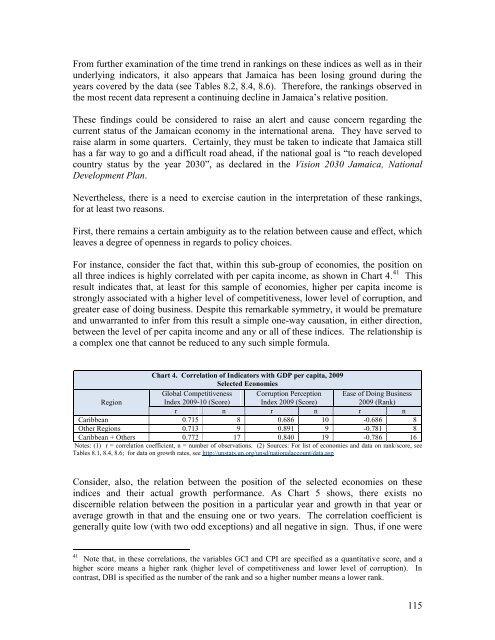PIOJ Growth-Inducement Strategy - Planning Institute of Jamaica
PIOJ Growth-Inducement Strategy - Planning Institute of Jamaica
PIOJ Growth-Inducement Strategy - Planning Institute of Jamaica
You also want an ePaper? Increase the reach of your titles
YUMPU automatically turns print PDFs into web optimized ePapers that Google loves.
From further examination <strong>of</strong> the time trend in rankings on these indices as well as in their<br />
underlying indicators, it also appears that <strong>Jamaica</strong> has been losing ground during the<br />
years covered by the data (see Tables 8.2, 8.4, 8.6). Therefore, the rankings observed in<br />
the most recent data represent a continuing decline in <strong>Jamaica</strong>’s relative position.<br />
These findings could be considered to raise an alert and cause concern regarding the<br />
current status <strong>of</strong> the <strong>Jamaica</strong>n economy in the international arena. They have served to<br />
raise alarm in some quarters. Certainly, they must be taken to indicate that <strong>Jamaica</strong> still<br />
has a far way to go and a difficult road ahead, if the national goal is “to reach developed<br />
country status by the year 2030”, as declared in the Vision 2030 <strong>Jamaica</strong>, National<br />
Development Plan.<br />
Nevertheless, there is a need to exercise caution in the interpretation <strong>of</strong> these rankings,<br />
for at least two reasons.<br />
First, there remains a certain ambiguity as to the relation between cause and effect, which<br />
leaves a degree <strong>of</strong> openness in regards to policy choices.<br />
For instance, consider the fact that, within this sub-group <strong>of</strong> economies, the position on<br />
all three indices is highly correlated with per capita income, as shown in Chart 4. 41 This<br />
result indicates that, at least for this sample <strong>of</strong> economies, higher per capita income is<br />
strongly associated with a higher level <strong>of</strong> competitiveness, lower level <strong>of</strong> corruption, and<br />
greater ease <strong>of</strong> doing business. Despite this remarkable symmetry, it would be premature<br />
and unwarranted to infer from this result a simple one-way causation, in either direction,<br />
between the level <strong>of</strong> per capita income and any or all <strong>of</strong> these indices. The relationship is<br />
a complex one that cannot be reduced to any such simple formula.<br />
Chart 4. Correlation <strong>of</strong> Indicators with GDP per capita, 2009<br />
Selected Economies<br />
Region<br />
Global Competitiveness<br />
Index 2009-10 (Score)<br />
Corruption Perception<br />
Index 2009 (Score)<br />
Ease <strong>of</strong> Doing Business<br />
2009 (Rank)<br />
r n r n r n<br />
Caribbean 0.715 8 0.686 10 -0.686 8<br />
Other Regions 0.713 9 0.891 9 -0.781 8<br />
Caribbean + Others 0.772 17 0.840 19 -0.786 16<br />
Notes: (1) r = correlation coefficient, n = number <strong>of</strong> observations. (2) Sources: For list <strong>of</strong> economies and data on rank/score, see<br />
Tables 8.1, 8.4, 8.6; for data on growth rates, see http://unstats.un.org/unsd/nationalaccount/data.asp<br />
Consider, also, the relation between the position <strong>of</strong> the selected economies on these<br />
indices and their actual growth performance. As Chart 5 shows, there exists no<br />
discernible relation between the position in a particular year and growth in that year or<br />
average growth in that and the ensuing one or two years. The correlation coefficient is<br />
generally quite low (with two odd exceptions) and all negative in sign. Thus, if one were<br />
41<br />
Note that, in these correlations, the variables GCI and CPI are specified as a quantitative score, and a<br />
higher score means a higher rank (higher level <strong>of</strong> competitiveness and lower level <strong>of</strong> corruption). In<br />
contrast, DBI is specified as the number <strong>of</strong> the rank and so a higher number means a lower rank.<br />
115
















